
Florida's Plunderin' Cowboy
Not all the cowboys in the country and not all the big dreams come from Texas. The state of Florida has its share of both, and those who go South seeking only glitter and gloss may be pleasantly surprised to discover that Florida boasts not only genuine cowboys, but a profusion of game even wilder than the mink on Miami Beach.
There is a large deer population in Florida and black bears grow to 300 pounds; big-tusked boars are almost as large. Rabbits, foxes, bobcats, raccoons and opossums are so abundant that seasons on them are open all year round. Florida's quail and dove shooting can hold its own with the best in the country, and wild turkeys are now so plentiful that there are two open seasons.
This happy hunting ground is the direct result of a realized dream. For generations the vast, swampy interior of the state—some two-thirds of Florida's entire land area—was as inaccessible to most people as the inner recesses of Palm Beach's Everglades Club. Tales of the terrors that lay between the twin strips of civilization along Florida's east and west coasts read like the billboard outside a Times Square horror picture. There were poisonous snakes, deadly scorpions, man-eating alligators, quicksand so perilous it sucked men beneath its surface in seconds and even mysterious and hostile Indian tribes.
How many of these stories were true is anybody's guess, but in the two decades following World War II, a group of 20th century cowboys managed to transform much of the "wild" interior into rich, fertile habitats where men, livestock and game thrive side by side. As a result, Florida has emerged not only as a cattle-producing region, but also as one of the top hunting states in the country.
Florida's modern cowboys are a blend of pioneer frontiersman, southern gentleman and Yankee entrepreneur that has no counterpart elsewhere in the U.S. Most are second- and third-generation Floridians, neither aristocrats nor Crackers but solid middle-class types with roots sunk deep in the land, the church and the community.
None is more typical of the group than Doyle Carlton Jr., a gangling native son who at first glance might have stepped from the pages of a Bonanza script. That is until his soft, southern speech and courtly plantation manners suggest recasting him as Ashley Wilkes in a modern version of Gone With the Wind.
Both impressions belie the shrewd, serious business mind and the dedication to a single goal that has shaped Carlton's life. Ever since he followed his first bobcat trail into the Everglades, his sole dream has been to tame and reclaim Florida's interior, not simply for himself but for the future.
"Even as a young pup," Carlton said recently on his 43,000-acre ranch in south central Hardee and De Soto counties, "I never got tired of just plunderin' around out here, thinking of all this land going to waste. I never liked to see anything wasted, especially land. Central Florida wasn't even any good for hunting then. The cover was too thick.
"You can set a covey of quail right on top of 100 pounds of the best quail food, but if the birds can't get through the cover to it, they will starve just the same as if there were no food there at all. That's true of most game. It was a real sorry sight to see all this land with so little able to live on it. I kept thinking of how much could be done with it if someone just took the trouble.
"After we got out of high school most of my friends took their first paychecks and put them down on second-hand jalopies. I took mine to the Wauchula bank and put it down on a piece of land. I wasn't as mobile as the others, but I sure felt like a man of property. I guess the feeling agreed with me, because I've been buying land ever since.
"Not that I always had the money to pay for it," Carlton grinned. "Most of the time I was mortgaged into the ground—literally. After 23 years of marriage and three children, I got around to building my wife a proper house only five years ago. But spending money on a lot of senseless luxuries never made much sense to us when there was good land for sale.
"Each time I managed to swing a new piece of property I'd lease it to some truck farmers or watermelon growers in exchange for their clearing it off. Then the next season I'd plant it in clover and carpet grass and put a few head of cattle on it. I grew some pretty raunchy looking critters in those days, but cattle raising was a new business in Florida then. It took a lot of pioneering to hit on the pasture and breed combinations that were right for this part of the country.
"Twenty years ago I used to think a 250-pound yearling was pretty good. Now, with improved pasture and breeding, our yearlings run at least 500 or 550 pounds. And we are still not satisfied. We keep trying to improve the land, not just to produce better cattle, but also to produce better hunting. It makes no sense anymore to develop land for only one use when it could be developed as practically, and as easily, for many uses. There is not enough land left for that kind of waste.
"What we are pioneering now is the working concept that good cattle range can also be good game range if it is developed with both game and cattle in mind. That also means preserving the natural cover and the beauty of the land and managing it in a way that utilizes the wildlife. My land produces two things—cattle and recreation. To me they are of equal importance. I never turn down anyone who wants to hunt or fish on my property as long as he asks permission. And everybody who comes here acts like he is having the time of his life. I guess he is. I sure know I am. But one day there are going to be more people wanting to hunt and fish here than my land, or any private land, will be able to handle. That is why we must have public land.
"Politicians talk on and on about schools, roads, industrial development, economy in government," Carlton explained as he trolled for bass along the four miles of Horse Creek that runs through his property. "But one of the most important issues today is recreational development. Almost nothing has been done to meet this need realistically. And the need becomes greater each year. But by the time its full impact is realized, most of the land that should have, and could have, been set aside for public recreation throughout the country will be gone. Then legislators will suddenly find themselves scurrying around trying to raise thousands of dollars an acre for land they might have bought for $75 or $100 today.
"The people who should be agitating right now to have such land set aside," Carlton said, "are the sportsmen. They are the people who would benefit most by it. But unfortunately too many of them are concerned not with the overall picture but with 'when is the season going to open?' or 'how do we get more deer?' The majority of hunters and fishermen are so divided by petty personal interests that they never get together to support the big issues. The only way to make certain that adequate lands are set aside for recreational purposes is to unite the public behind the idea. Get them to shout loud and strong for it. It is surprising how quickly legislators respond to a shouting public."
The son of a longtime state legislator who was Florida's governor from 1929 to 1933, Carlton has himself been a Florida lawmaker (from the 27th district) for three terms. In 1953, at the age of 30, he was named Florida's outstanding freshman legislator. Over the years his persistent efforts to open new hunting and fishing areas to the public, to add to those owned and leased by the state, to improve and increase game habitats as well as game populations in Florida have earned Carlton a statewide reputation as the "sporting senator."
The title fits him as well in the field as on the senate floor. Carlton is as rugged and tough as the ranch he runs. There is no part of its operation that he cannot perform as well as the best of his ranch hands, a fact that contributes considerably to their admiration for him. Doyle Carlton has become a rich man in the years since he made his first down payment on a parcel of swampland, but little has changed to indicate this. A deacon of the First Baptist Church of Wauchula, he neither smokes nor drinks, although he confesses to a fondness for sweets and buttermilk. He still prefers driving a pickup truck to the family sedan, but in the last year he has developed a strong affection for the Cessna 182 which he has been learning to fly.
Carlton's now graying hair, still cropped to a bristle, is the only thing about him that suggests his 44 years. His big, 195-pound frame is as lean and muscular as a college athlete's. Most mornings, in fact, he runs a fast mile before climbing into the saddle for what may end up being 15 or 18 hours of cattle cutting, bobcat chasing, quail shooting, boar hunting or—as he likes to describe the casual combination of all these activities plus a little fishing, exploring and daydreaming—just plain plunderin'.
"It would be a pretty sorry life to live," he said as we watched a pair of deer browse at the edge of a grass field, "if there were no land left where a man could get away to do some plunderin' every now and then."
PHOTO

